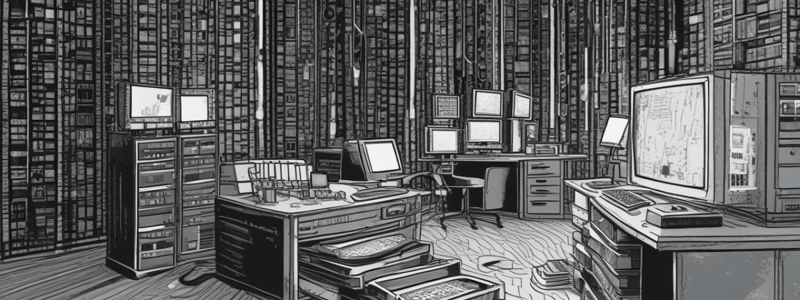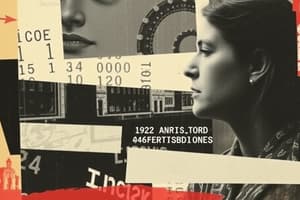Podcast
Questions and Answers
What is the binary representation of the decimal number 145?
What is the binary representation of the decimal number 145?
10010001
What does the computer interpret the letter 'a' as in binary?
What does the computer interpret the letter 'a' as in binary?
01100001
Binary has a base-2 system with numerals 0 and 1. (True/False)
Binary has a base-2 system with numerals 0 and 1. (True/False)
True (A)
Which character encoding scheme is widely used for most European languages?
Which character encoding scheme is widely used for most European languages?
A byte consists of __ bits.
A byte consists of __ bits.
How many possible combinations of 2-bit binary numbers are there?
How many possible combinations of 2-bit binary numbers are there?
What is the base of the binary system?
What is the base of the binary system?
A byte can store exactly one character.
A byte can store exactly one character.
How many bytes are in a kilobyte?
How many bytes are in a kilobyte?
Match the following character encoding schemes with their descriptions:
Match the following character encoding schemes with their descriptions:
Flashcards are hidden until you start studying
Study Notes
Storing Data
- Computers store all data in binary, which is crucial to understand.
- Bits are how a computer reads all data, and it has taken many individuals and companies years to learn how to translate human data into computer-readable data.
- Any data can be converted into binary digits, such as numbers, pictures, text messages, voice messages, and colors.
Binary Data Representation
- Integers can be converted into bits, which allows computers to understand letters.
- The computer stores a combination of 0s and 1s that represent a letter, rather than the symbol itself.
- The concept of data representation using binary is an ancient one, dating back to smoke signals and Morse Code.
- New ways of representing data using binary interpretation are being invented, such as on and off voltage, high and low frequency radio waves, and open and closed vacuum tubes.
Bits and Bytes
- A "bit" is a single binary digit holding either a value of 1 or 0.
- There are 4 possible combinations of 2-bit binary numbers (00, 01, 10, 11).
- The number of possible combinations doubles with every bit that is added on (e.g., 3-bit binary digits have 8 possible combinations, 4-bit binary digits have 16 possible combinations, etc.).
- A byte is a group of 8 bits, which provides enough combinations to store all necessary single characters on a keyboard.
Computer Memory
- Computer memory is stored in bytes.
- A kilobyte (kB) is equal to 1024 bytes and can hold about 1 paragraph of text.
- A megabyte (MB) is equal to 1024 kB and can hold a song or audio clip.
- A gigabyte (GB) is equal to 1024 MB and is currently used to describe the storage size of most devices.
- There are also larger units of measurement, such as terabytes (TB) and petabytes (PB), which are used to store larger amounts of data.
ASCII Chart
- The ASCII Table is a protocol that assigns binary numbers to characters, and it has been globally agreed upon and recognized.
- The table encodes numbers, letters, symbols, and punctuation, as well as non-printable commands such as ENTER or ESC.
- The chart is based on English letters, but other languages translate their letters to English equivalents that align with the chart.
- The binary digits listed on the chart always start with a 1, and leading 0s are implied.
- Hexadecimal and octal equivalents are provided on the chart.
Data Representation
- There are many ways to display data, including reports, charts, graphs, illustrations, frequency distribution tables, histograms, scatter plots, etc.
- Choosing the correct way to show the information is an important skill for a data scientist.
- Different representations will be appropriate for different data sets, and need to be selected wisely.
Storing Data
- Computers store all data in binary, which is crucial to understand.
- Bits are how a computer reads all data, and it has taken many individuals and companies years to learn how to translate human data into computer-readable data.
- Any data can be converted into binary digits, such as numbers, pictures, text messages, voice messages, and colors.
Binary Data Representation
- Integers can be converted into bits, which allows computers to understand letters.
- The computer stores a combination of 0s and 1s that represent a letter, rather than the symbol itself.
- The concept of data representation using binary is an ancient one, dating back to smoke signals and Morse Code.
- New ways of representing data using binary interpretation are being invented, such as on and off voltage, high and low frequency radio waves, and open and closed vacuum tubes.
Bits and Bytes
- A "bit" is a single binary digit holding either a value of 1 or 0.
- There are 4 possible combinations of 2-bit binary numbers (00, 01, 10, 11).
- The number of possible combinations doubles with every bit that is added on (e.g., 3-bit binary digits have 8 possible combinations, 4-bit binary digits have 16 possible combinations, etc.).
- A byte is a group of 8 bits, which provides enough combinations to store all necessary single characters on a keyboard.
Computer Memory
- Computer memory is stored in bytes.
- A kilobyte (kB) is equal to 1024 bytes and can hold about 1 paragraph of text.
- A megabyte (MB) is equal to 1024 kB and can hold a song or audio clip.
- A gigabyte (GB) is equal to 1024 MB and is currently used to describe the storage size of most devices.
- There are also larger units of measurement, such as terabytes (TB) and petabytes (PB), which are used to store larger amounts of data.
ASCII Chart
- The ASCII Table is a protocol that assigns binary numbers to characters, and it has been globally agreed upon and recognized.
- The table encodes numbers, letters, symbols, and punctuation, as well as non-printable commands such as ENTER or ESC.
- The chart is based on English letters, but other languages translate their letters to English equivalents that align with the chart.
- The binary digits listed on the chart always start with a 1, and leading 0s are implied.
- Hexadecimal and octal equivalents are provided on the chart.
Data Representation
- There are many ways to display data, including reports, charts, graphs, illustrations, frequency distribution tables, histograms, scatter plots, etc.
- Choosing the correct way to show the information is an important skill for a data scientist.
- Different representations will be appropriate for different data sets, and need to be selected wisely.
Studying That Suits You
Use AI to generate personalized quizzes and flashcards to suit your learning preferences.




